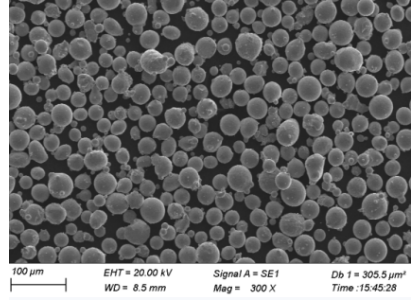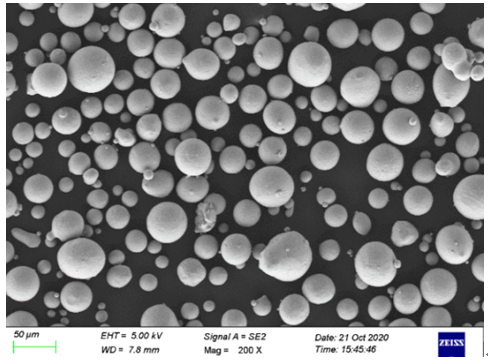Welcome to the ultimate guide on PREP-prepared powders! If you’ve been diving into the world of metal powders, you’re in the right place. We’ll cover everything you need to know, from what PREP-prepared powders are, to their specific models, properties, and applications. So, let’s get started!
Overview of PREP-Prepared Powders
PREP, or Plasma Rotating Electrode Process, is a cutting-edge technique for producing high-quality metal powders. This method ensures superior sphericity, purity, and uniformity, making it ideal for various industrial applications. Whether you’re into additive manufacturing, metallurgy, or any other field that relies on top-notch metal powders, PREP-prepared powders are worth considering.
What Are PREP-Prepared Powders?
PREP-prepared powders are created using the Plasma Rotating Electrode Process. In this method, a rod of the desired metal is melted at the tip using a plasma arc. As the rod rotates at high speeds, centrifugal force causes the molten droplets to fly off, cooling and solidifying into nearly perfect spherical powders. This results in powders with minimal contamination and excellent flowability, crucial for precise and high-quality production processes.

Composition of PREP-Prepared Powders
Understanding the composition of PREP-prepared powders is essential for selecting the right material for your needs. Here’s a detailed look:
| Metal Type | Composition | Key Characteristics |
|---|---|---|
| Titanium | Ti-6Al-4V | High strength, low density, excellent corrosion resistance |
| Aluminum | Al-Si10Mg | Lightweight, high thermal conductivity, good mechanical properties |
| Nickel | Inconel 718 | High strength, oxidation resistance, maintains properties at high temperatures |
| Steel | 316L Stainless | High corrosion resistance, good weldability, durable |
| Cobalt-Chrome | CoCrMo | High wear resistance, biocompatible, strength at high temperatures |
| Copper | Cu-OFHC | High electrical and thermal conductivity, excellent formability |
| Tungsten | W-Ni-Fe | High density, good thermal and electrical conductivity, high melting point |
| Molybdenum | Mo-TZM | High strength, good thermal conductivity, high melting point |
| Magnesium | AZ31B | Lightweight, good strength-to-weight ratio, corrosion resistant |
| Silver | Ag-999 | Highest electrical and thermal conductivity, antibacterial properties |
Characteristics of PREP-Prepared Powders
The characteristics of PREP-prepared powders set them apart from other types of metal powders. Let’s break down these attributes:
| Characteristic | Description |
|---|---|
| Sphericity | Nearly perfect spheres for optimal flow and packing density |
| Purity | Minimal contamination due to controlled production environment |
| Particle Size Uniformity | Consistent particle sizes enhance process reliability |
| High Bulk Density | Improved material handling and storage efficiency |
| Excellent Flowability | Facilitates smooth processing in additive manufacturing and other applications |
Applications of PREP-Prepared Powders
PREP-prepared powders find applications in numerous industries due to their superior qualities. Here’s a glimpse into where they shine:
| Application | Industries |
|---|---|
| Additive Manufacturing (3D Printing) | Aerospace, automotive, medical implants, consumer products |
| Powder Metallurgy | Tooling, automotive parts, machinery components |
| Coatings | Protective coatings for aerospace, industrial machinery |
| Electronics | Conductive inks, thermal management solutions |
| Medical | Implants, prosthetics, dental restorations |






Specific Models of PREP-Prepared Powders
Titanium (Ti-6Al-4V)
- Composition: Titanium, Aluminum, Vanadium
- Properties: High strength-to-weight ratio, excellent corrosion resistance, biocompatibility
- Applications: Aerospace components, medical implants, high-performance automotive parts
Aluminum (Al-Si10Mg)
- Composition: Aluminum, Silicon, Magnesium
- Properties: Lightweight, high thermal conductivity, good mechanical properties
- Applications: Automotive parts, consumer electronics, lightweight structural components
Nickel (Inconel 718)
- Composition: Nickel, Chromium, Iron, Niobium, Molybdenum
- Properties: High strength, excellent oxidation resistance, maintains properties at high temperatures
- Applications: Turbine blades, aerospace components, high-temperature fasteners
Steel (316L Stainless)
- Composition: Iron, Chromium, Nickel, Molybdenum
- Properties: High corrosion resistance, good weldability, durability
- Applications: Medical devices, food processing equipment, marine applications
Cobalt-Chrome (CoCrMo)
- Composition: Cobalt, Chromium, Molybdenum
- Properties: High wear resistance, biocompatible, strength at high temperatures
- Applications: Dental and medical implants, aerospace components, industrial tooling
Copper (Cu-OFHC)
- Composition: Oxygen-Free High Conductivity Copper
- Properties: High electrical and thermal conductivity, excellent formability
- Applications: Electrical components, heat exchangers, electronic devices
Tungsten (W-Ni-Fe)
- Composition: Tungsten, Nickel, Iron
- Properties: High density, good thermal and electrical conductivity, high melting point
- Applications: Radiation shielding, aerospace components, electrical contacts
Molybdenum (Mo-TZM)
- Composition: Molybdenum, Titanium, Zirconium, Carbon
- Properties: High strength, good thermal conductivity, high melting point
- Applications: Aerospace components, industrial furnaces, tooling
Magnesium (AZ31B)
- Composition: Magnesium, Aluminum, Zinc
- Properties: Lightweight, good strength-to-weight ratio, corrosion resistant
- Applications: Automotive components, aerospace parts, portable electronics
Silver (Ag-999)
- Composition: Pure Silver
- Properties: Highest electrical and thermal conductivity, antibacterial properties
- Applications: Electrical contacts, medical devices, antimicrobial coatings
Grades of PREP-Prepared Powders
Grades of PREP-prepared powders vary based on their specific applications and required properties. Here’s a detailed breakdown:
| Grade | Description | Applications |
|---|---|---|
| Grade 1 | High purity, premium sphericity | Aerospace, medical |
| Grade 2 | Standard purity, good sphericity | Automotive, consumer products |
| Grade 3 | Industrial grade, acceptable sphericity | General manufacturing, tooling |
| Custom Grades | Tailored compositions and properties | Specific industrial needs |
Specifications of PREP-Prepared Powders
Accurate specifications are crucial for selecting the right PREP-prepared powder. Here’s a table outlining common specifications:
| Metal Type | Particle Size Range (μm) | Bulk Density (g/cm³) | Flow Rate (s/50g) | Purity (%) |
|---|---|---|---|---|
| Titanium | 15-45 | 4.43 | 18 | 99.9 |
| Aluminum | 20-60 | 2.70 | 15 | 99.8 |
| Nickel | 10-50 | 8.19 | 22 | 99.7 |
| Steel | 20-70 | 7.95 | 25 | 99.5 |
| Cobalt-Chrome | 15-50 | 8.30 | 23 | 99.8 |
| Copper | 10-45 | 8.96 | 17 | 99.9 |
| Tungsten | 15-50 | 19.25 | 30 | 99.5 |
| Molybdenum | 20-60 | 10.22 | 27 | 99.8 |
| Magnesium | 15-45 | 1.74 | 20 | 99.7 |
| Silver | 10-40 | 10.49 | 14 | 99.9 |
Suppliers and Pricing Details of PREP-Prepared Powders
Finding the right supplier and understanding the pricing structure is vital. Here’s an overview:
| Supplier | Metal Type | Price Range (per kg) | Lead Time | MOQ (Minimum Order Quantity) |
|---|---|---|---|---|
| Supplier A | Titanium | $150 – $300 | 4 weeks | 10 kg |
| Supplier B | Aluminum | $50 – $120 | 3 weeks | 20 kg |
| Supplier C | Nickel | $200 – $400 | 5 weeks | 5 kg |
| Supplier D | Steel | $30 – $80 | 2 weeks | 50 kg |
| Supplier E | Cobalt-Chrome | $250 – $500 | 6 weeks | 10 kg |
| Supplier F | Copper | $40 – $90 | 3 weeks | 25 kg |
| Supplier G | Tungsten | $500 – $900 | 8 weeks | 5 kg |
| Supplier H | Molybdenum | $150 – $350 | 4 weeks | 10 kg |
| Supplier I | Magnesium | $100 – $200 | 3 weeks | 20 kg |
| Supplier J | Silver | $700 – $1500 | 5 weeks | 5 kg |
Advantages and Limitations of PREP-Prepared Powders
Choosing the right powder involves weighing the pros and cons. Here’s a comparison:
| Metal Type | Advantages | Limitations |
|---|---|---|
| Titanium | High strength, corrosion resistance, biocompatibility | Expensive, difficult to machine |
| Aluminum | Lightweight, good conductivity, cost-effective | Lower strength compared to other metals |
| Nickel | High temperature resistance, strength | Expensive, heavier than alternatives |
| Steel | Durable, corrosion resistant, cost-effective | Heavier, can rust without proper treatment |
| Cobalt-Chrome | Wear resistance, biocompatibility | Expensive, challenging to process |
| Copper | Excellent conductivity, formability | Susceptible to oxidation, relatively soft |
| Tungsten | High density, thermal stability | Very heavy, difficult to process |
| Molybdenum | High strength, thermal conductivity | Expensive, brittle at room temperature |
| Magnesium | Lightweight, good strength-to-weight ratio | Flammable, lower strength |
| Silver | Best conductivity, antibacterial | Very expensive, prone to tarnishing |

FAQ
| Question | Answer |
|---|---|
| What is the Plasma Rotating Electrode Process (PREP)? | PREP is a method for creating high-quality metal powders by melting a rotating rod of metal with a plasma arc, producing nearly perfect spherical powders. |
| What are the main benefits of using PREP-prepared powders? | They offer superior sphericity, high purity, uniform particle size, and excellent flowability, making them ideal for various industrial applications. |
| In which industries are PREP-prepared powders most commonly used? | They are widely used in additive manufacturing, powder metallurgy, coatings, electronics, and medical industries. |
| How do PREP-prepared powders compare to other metal powders? | PREP-prepared powders generally offer better sphericity, purity, and uniformity compared to powders produced by other methods, which translates to higher performance in applications. |
| Can I get customized PREP-prepared powders? | Yes, many suppliers offer custom grades and compositions to meet specific industrial needs. |
| What factors should I consider when selecting a PREP-prepared powder? | Consider the metal type, particle size, purity, bulk density, flow rate, and specific application requirements. |
| Are there any limitations to using PREP-prepared powders? | They can be more expensive and, depending on the metal, may have specific processing challenges. |
| How can I ensure the quality of PREP-prepared powders? | Choose reputable suppliers, verify the specifications and certifications, and conduct quality testing as needed for your application. |
| What are some key properties to look for in PREP-prepared powders? | Sphericity, purity, particle size uniformity, bulk density, and flowability are crucial properties to consider. |
| Are PREP-prepared powders environmentally friendly? | The process minimizes contamination and waste, but the environmental impact depends on the specific metal and application. Always consider the entire lifecycle and recycling options for your material. |
Conclusion
PREP-prepared powders represent a significant advancement in the world of metal powders, offering unparalleled quality and performance. Whether you’re involved in aerospace, automotive, medical, or any other high-tech industry, understanding the intricacies of these powders can greatly enhance your project’s success. With this comprehensive guide, you’re well-equipped to make informed decisions and leverage the full potential of PREP-prepared powders.

